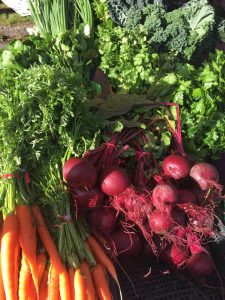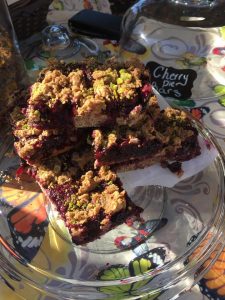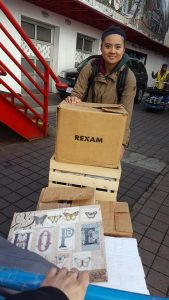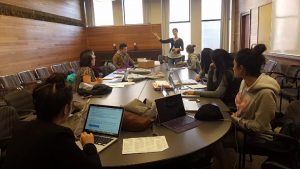Project Proposal: See here
Weekly Objectives and Achievements
| Weekly Objectives | Achievements | |
| Week 1 | Decide on a Community Project
|
We were all assigned to prefered projects |
| Week 2 | Meet Group
Complete Terms of Reference Set up Group Blog |
We introduced ourselves and collectively agreed on a Terms Of Reference to start the foundation of this group project
We created a platform for communications (Facebook group) and a shared drive online to access our work We created our group blog site and ensured that everyone had access |
| Week 3 | Finish 1st Group Blog Posting (Sept 22)
Meet with Community Partner Determine group goals and objectives Develop rough idea of project schedule for the term |
Established a plan for our initial visit to the farmers’ market
Met with Community Partner to establish expectations Roughly decided on our main focus question and that we would likely do quantitative research Created Group Calendar online |
| Week 4 | Finish Tara’s Data Entry (Sept 30)
Complete Research Ethics Tutorial Online (Oct 1) |
Group decided not to go forward with completing data entry by Sept 30 → deadline extended and expectations lowered
Everyone finished Research Ethics Tutorial online |
| Week 5 | Visit Farmer’s Markets (Sept 30th and Oct 1st) | The group split into two teams; 3 went to Lonsdale on Saturday and 3 went to Ambleside on Sunday. Lonsdale group focused on volunteer work and Ambleside group focused on conversations with vendors. Both groups returns with a good idea of what main concepts would need to be included on the surveys. |
| Week 6 | Meeting with Community Partner
Completion of Proposal Proposal Revision with Community Partner Completion of Interview Questions Preparing the surveys Blog post 2 due Proposal due |
Both Artisan Farmer’s Market groups met with the community partner to clarify and finalize interview/survey questions
The project proposal was finished, submitted and approved by the community partner The group set weekly objectives for the rest of the semester It was decided to use ANOVA methods to analyze quantitative data Survey interview questions formed Blog post was submitted! |
| Week 7 | Next trip to the farmers markets to conduct surveys. October 21st and 22nd. Questions have been approved by Tara and it looks like she likes our proposal and our project is pretty much formed. | |
| Week 8 | Team working meeting: Cold call and email randomly selected vendors to complete survey | |
| Week 9 | Mapping moments of significance
Blog post due (Nov 5) |
|
| Week 10 | Team working meeting:
|
|
| Week 11 | Complete initial draft of infographic | |
| Week 12 | Define expectations and create strategies for completing our final project and deliverables
Discuss capacity building as essential in creating sustained change in communities Final blog post due (November 26) Submit infographic |
|
| Week 13 | Presentation at public poster night in the AMS Nest (November 29th) | |
| Week 14 | Final project report |
Highlights so far…
Visiting the farmers’ markets





Meeting with community partner

Putting together survey questions

REFLECTIONS:
What, So What, Now What? – Reflecting on a moment of significance that has occurred in the course so far…
WHAT?
When we were first introduced to the project, it was clear what the Artisan Farmers’ Markets’ objective was. However, we felt so overwhelmed by the prospect of how to achieve their objective and our class objectives, that we didn’t feel like we could do both. During Week 2, we learned about Asset-based Community Development in class. This concept challenged us to learn to listen and to only move forward with projects that were of importance to the communities. We began to realize that we didn’t just have one partner, the Artisan Farmers’ Markets, in this project – in reality, we had two.
We were in a situation where we were trying to meet the academic goals and learning objectives of the course we were taking. This involved structured requirements set out not only by the course but in order to satisfy the faculty and university we study in. At the same time, we were also tasked with trying to fulfil the needs and objectives of a completely separate non-profit partner. Not only did both of these organizations have different ideas about how to structure the project and its final outcomes, but the missions that drive the actions of both organizations are also fundamentally distinct. At this stage we felt stuck, without a set plan to confidently move forward. How could we possibly achieve such seemingly different objectives? How would we communicate between two parties that thought and acted so differently? How would we manage everything? Which objectives would we prioritize? There were so many things to think about. And, as it turned out, class couldn’t prepare us for how to deal with what happens when multiple partner objectives were in contrast with each other – only real world experience could do that.
SO WHAT?
We stayed frustrated and overwhelmed for a couple of weeks. We tried to communicate to our academic partner that we weren’t sure if we were able to meet all of our class goals while focusing 100% of our efforts on the Artisan Farmers Markets’ goals. We tried to communicate to the Artisan Farmers Markets that we were nervous that we wouldn’t be able to fully complete their main objective if we were also to prioritize our academic requirements. It wasn’t until we had a face-to-face conversation with our TA (our most direct link and representative of our academic partner) that we were able to start to fully understand how the bulk of both partners’ objectives could still be met simultaneously and realistically.
Eureka moment!
It was after this that we started to gain confidence in our set objectives, proposal, and project as a whole. We now started to realize that although this kind of dilemma is frustrating and not always simple to find solutions around, it happens in real life to non-profits and academics – all the time. We had finished the lecture during Week 2 with the false impression that there is only ever one partner whose needs we need to take into account when taking on a project. But, this is not the case in many situations. What happens when a government has to pass a law that will satisfy the needs of multiple constituencies? What happens when a non-profit carries out a project using third-party funding and their objectives don’t really match with the community’s? What happens when a researcher is paid by their own government to take on a project in a foreign country? Or when an employee has to complete a task that will fulfil the needs of multiple departments at work? There is rarely ever just one community partner. Asset-based Community Development can and most often will mean listening to and fulfilling the objectives of multiple communities whose needs may possibly be contradictory.
NOW WHAT?
This realization didn’t make the situation any less frustrating or suddenly allowed us to satisfy each partner perfectly. But, it did give us the inspiration and confidence to find solutions to move forward.
First, We needed to talk to each other. We were in a unique situation where not only were we working with two different partners, but each of our partners was working with two groups of us. Yet, both our North Van group and the Burnaby group hadn’t communicated much during the early days of the project planning. Because of this we had been feeling overwhelmed separately, instead of finding ways to move forward together. During the same face-to-face that we had with our TA and professor, we also had a check-in with each other and decided collectively to start steering away from trying to satisfy 100% of the Artisan Farmers’ Markets’ objectives in order to make sure we were meeting the needs of everyone.
We needed to compromise. Some of the Artisan Farmers’ Markets; key objectives were simpler tasks that we didn’t feel challenged us in anyway. But, in order to compromise we would still have to try them. Our group finished as much of our community partner’s data entry as we reasonably could amidst deadlines and our other responsibilities. When it was time to shift gears towards the research portion of the project, our community partner agreed to accept the work we had achieved so far – even though it was not 100% completed. We also knew that during our initial farmers’ market visits we wouldn’t be able to attend as volunteers and get all the responses from all the vendors that we needed to build the surveys. Instead, when the time came to attend, we split up into two groups; one focussed their time primarily on volunteering and the other ensured that they visited and had conversations with every single vendor at the market.
We needed to make hard decisions. Coming to the decision to make those compromises wasn’t easy for us. It still isn’t easy. We are still deciding whether we should split the group between volunteers and surveyors during our next market visit or commit strictly to our surveys. Encouraging the Artisan Farmers Markets to make these decisions with us is what really helped us make executive decisions.
Identifying upcoming objectives and strategies to achieve them.
Now that our proposal is completed, finalized, and approved by our community partner, we can now get to the fun stuff and actually start this research project! We have selected new dates to visit the Artisan Farmers’ Markets. The group will be split into 2 teams with 3 members each visiting Lonsdale Quay on October 21st and the Ambleside location on October 22nd. Here are our upcoming tasks as we move forward with our project:
Task 1: To finalize and format our physical survey and interview questions and decide on effective data collection methods
(Week 6/7)
-
- Have our community partner to give us tips on how to formulate questions that are appropriate and quantifiable for ANOVA analysis;
- Develop proper wording and framing for specific answers formatted for analysis and supports the research question;
- Ask for tips on when to approach vendors to extract the best information we can during interviews; and,
- Make the survey an appropriate length that is concise, visually appealing, and easy to administer, collect data, and self-report.
Task 2: Finalize project timeline and deadlines for goals on data analysis and report writing (Week 7)
-
- Start collaborative google doc to plan our timeline for the rest of the semester;
- Prompt data entry onto excel as soon as possible after it has been collected; and,
- Keep data organized and accessible.
Task 3: Find common themes from our interview data and connect the dots
(Week 8-9)
-
- After transcribing recordings/interview responses, start categorizing data and look for supporting quotes that give the report credibility;
- Begin discussing commonalities among the compiled data for analysis that supports a conclusion and gives us the insight on next steps; and,
- Keep all group members engaged and participating when discussing trends.
Task 4: Work on group cooperation and communication
(Ongoing)
-
- Ensure that all group members are informed and on-top of our research;
- Keep group members caught-up with new data entries, ideas, correlations, conclusions, and discussions; and,
- Keep up with deadlines to ensure the project is following the timeline and to resolve and obstacles that arise.